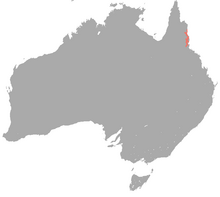
Diprotodontia is the largest extant order of marsupials, with about 155 species, including the kangaroos, wallabies, possums, koala, wombats, and many others. Extinct diprotodonts include the hippopotamus-sized Diprotodon, and Thylacoleo, the so-called "marsupial lion".

The broad-faced potoroo is an extinct potoroid marsupial that was found in southwestern Australia. The first specimen was collected in 1839, and described by John Gould in 1844. Only a small number of specimens have been collected since. The last live capture was in 1875. Subfossil remains indicate that it had an extensive distribution around the semiarid coastal districts of Southwest Australia.
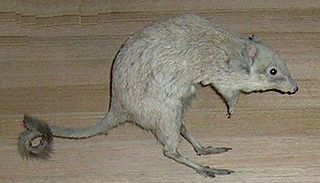
Potoroidae is a family of marsupials, small Australian animals known as bettongs, potoroos, and rat-kangaroos. All are rabbit-sized, brown, jumping marsupials and resemble a large rodent or a very small wallaby.
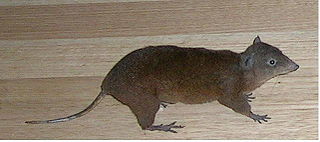
The Hypsiprymnodontidae are a family of macropods, one of two families containing animals commonly referred to as rat-kangaroos. The single known extant genus and species in this family, the musky rat-kangaroo, Hypsiprymnodon moschatus, occurs in northern Australia. During the Pleistocene, this family included the megafauna genus Propleopus.

Hypsiprymnodon is a genus of macropods. The sole extant species is Hypsiprymnodon moschatus, the musky rat-kangaroo. The genus includes four known fossil species.

The long-nosed potoroo is a small, hopping mammal native to forests and shrubland of southeastern Australia and Tasmania. A member of the potoroo and bettong family (Potoroidae), it lives alone and digs at night for fungi, roots, or small insects. It is also a marsupial and carries its young in a pouch. The long-nosed potoroo is threatened by habitat loss and introduced species such as cats or foxes. There are two subspecies: P. t. tridactylus on mainland Australia, and P. t. apicalis on Tasmania, with lighter fur.

Gilbert's potoroo or ngilkat is Australia's most endangered marsupial, the rarest marsupial in the world, and one of the world's rarest critically endangered mammals, found in south-western Western Australia. It is a small nocturnal macropod that lives in small groups.

Potoroo is a common name for species of Potorous, a genus of smaller marsupials. They are allied to the Macropodiformes, the suborder of kangaroo, wallaby, and other rat-kangaroo genera. All three extant species are threatened by ecological changes since the colonisation of Australia, especially the long-footed potoroo Potorous longipes (endangered) and P. gilbertii. The broad-faced potoroo P. platyops disappeared after its first description in the 19th century. The main threats are predation by introduced species and habitat loss.
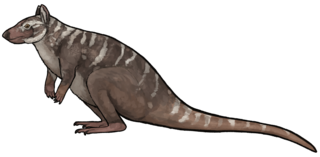
Ekaltadeta is an extinct genus of marsupials related to the modern musky rat-kangaroos. Ekaltadeta was present in what is today the Riversleigh formations in Northern Queensland from the Late Oligocene to the Miocene, and the genus includes three species. The genus is hypothesized to have been either exclusively carnivorous, or omnivorous with a fondness for meat, based on the chewing teeth found in fossils. This conclusion is based mainly on the size and shape of a large buzz-saw-shaped cheek-tooth, the adult third premolar, which is common to all Ekaltadeta.
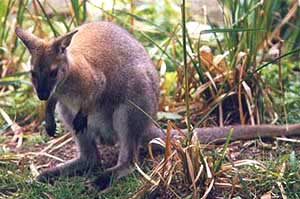
The Macropodiformes, also known as macropods, are one of the three suborders of the large marsupial order Diprotodontia. They may in fact be nested within one of the suborders, Phalangeriformes. Kangaroos, wallabies and allies, bettongs, potoroos and rat kangaroos are all members of this suborder.

The boodie, also known as the burrowing bettong or Lesueur's rat-kangaroo, is a small, furry, rat-like mammal native to Australia. Once common throughout the continent, it is now restricted to a few coastal islands. A member of the rat-kangaroo family (Potoroidae), it lives in burrows and is active at night when it forages for fungi, roots, and other plant matter. It is about the size of a rabbit and, like most marsupials, carries its young in a pouch.
The long-footed potoroo is a small marsupial found in southeastern Australia, restricted to an area around the coastal border between New South Wales and Victoria. It was first recorded in 1967 when an adult male was caught in a dog trap in the forest southwest of Bonang, Victoria. It is classified as vulnerable.

The rufous rat-kangaroo or rufous bettong is a small, jumping, rat-like marsupial native to eastern Australia. It is the only species in the genus Aepyprymnus. The largest member of the potoroo/bettong family (Potoroidae), it is about the size of a rabbit. The rufous rat-kangaroo is active at night when it digs for plant roots and fungi, and like other marsupials it carries its young in a pouch. Though its range is reduced, the population is healthy and stable.

Bettongs, species of the genus Bettongia, are potoroine marsupials once common in Australia. They are important ecosystem engineers displaced during the colonisation of the continent, and are vulnerable to threatening factors such as altered fire regimes, land clearing, pastoralism and introduced predatory species such as the fox and cat.
Mesolaelaps is a genus of mites in the family Laelapidae. The small macropod species Hypsiprymnodon moschatus, the musky rat kangaroo, is recorded as a to host species of this mite.
Trichosurolaelaps is a genus of mites in the family Hirstionyssidae. The small macropod species Hypsiprymnodon moschatus, the musky rat kangaroo, is recorded as a host to species of this mite.
The Macropodidae are an extant family of marsupial with the distinction of the ability to move bipedally on the hind legs, sometimes by jumping, as well as quadrupedally. They are herbivores, but some fossil genera like Ekaltadeta are hypothesised to have been carnivores. The taxonomic affiliations within the family and with other groups of marsupials is still in flux.
Hypsiprymnodon karenblackae is a fossil species describing a small marsupial extant in Australia during the Early to Middle Miocene Epoch. The material was collected at the Australian Fossil Mammal Sites (Riversleigh). The taxon was published in 2014, along with several other new species of the genus Hypsiprymnodon, known as musky rat-kangaroos. The morphology of the teeth suggest it existed in a wet rainforest environment, similar to the ecological conditions of the extant species, the musky rat-kangaroo. The type specimen was collected at the Camel Sputum site, classified as a Faunal Zone B (Miocene) deposit at Riversleigh in northwestern Queensland, The epithet is for Dr. Karen Black's contribution to palaeontology in Australia, especially the Riversleigh fossils.
Bulungamayinae is an extinct subfamily that allies fossil species of marsupials, showing close morphological features found in the modern potoroines, the bettongs and potoroos of Australia.
Palaeopotorous priscus is a fossil species of a diprotodont marsupial, known from specimens obtained in central Australia. The animal was similar to the modern species of the family Potoroidae, the potoroos and bettongs.

